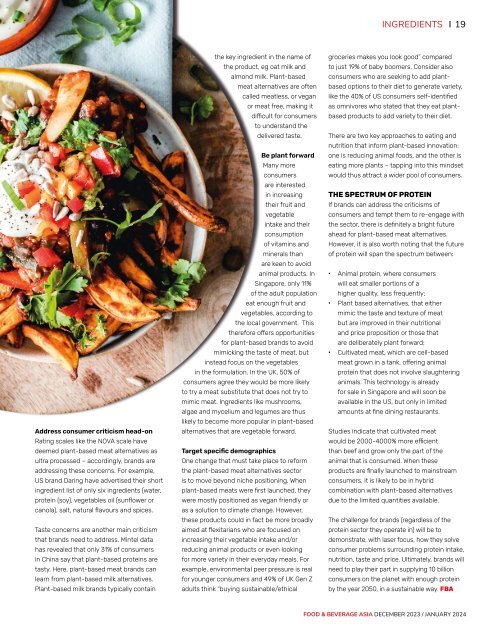Food & Beverage Asia December/January 2024
Food & Beverage Asia (FBA) is the leading source of food and beverage news in Asia since 2002. FBA delivers a comprehensive view of the food and beverage landscape, spanning across the latest health and nutrition trends and industry innovations in ingredients, recipe formulations, food science, sustainability, packaging, and automation, as well as advancements in agri and food-tech.
Food & Beverage Asia (FBA) is the leading source of food and beverage news in Asia since 2002. FBA delivers a comprehensive view of the food and beverage landscape, spanning across the latest health and nutrition trends and industry innovations in ingredients, recipe formulations, food science, sustainability, packaging, and automation, as well as advancements in agri and food-tech.
You also want an ePaper? Increase the reach of your titles
YUMPU automatically turns print PDFs into web optimized ePapers that Google loves.
INGREDIENTS 19<br />
Address consumer criticism head-on<br />
Rating scales like the NOVA scale have<br />
deemed plant-based meat alternatives as<br />
ultra processed – accordingly, brands are<br />
addressing these concerns. For example,<br />
US brand Daring have advertised their short<br />
ingredient list of only six ingredients (water,<br />
protein (soy), vegetables oil (sunflower or<br />
canola), salt, natural flavours and spices.<br />
Taste concerns are another main criticism<br />
that brands need to address. Mintel data<br />
has revealed that only 31% of consumers<br />
in China say that plant-based proteins are<br />
tasty. Here, plant-based meat brands can<br />
learn from plant-based milk alternatives.<br />
Plant-based milk brands typically contain<br />
the key ingredient in the name of<br />
the product, eg oat milk and<br />
almond milk. Plant-based<br />
meat alternatives are often<br />
called meatless, or vegan<br />
or meat free, making it<br />
difficult for consumers<br />
to understand the<br />
delivered taste.<br />
Be plant forward<br />
Many more<br />
consumers<br />
are interested<br />
in increasing<br />
their fruit and<br />
vegetable<br />
intake and their<br />
consumption<br />
of vitamins and<br />
minerals than<br />
are keen to avoid<br />
animal products. In<br />
Singapore, only 11%<br />
of the adult population<br />
eat enough fruit and<br />
vegetables, according to<br />
the local government. This<br />
therefore offers opportunities<br />
for plant-based brands to avoid<br />
mimicking the taste of meat, but<br />
instead focus on the vegetables<br />
in the formulation. In the UK, 50% of<br />
consumers agree they would be more likely<br />
to try a meat substitute that does not try to<br />
mimic meat. Ingredients like mushrooms,<br />
algae and mycelium and legumes are thus<br />
likely to become more popular in plant-based<br />
alternatives that are vegetable forward.<br />
Target specific demographics<br />
One change that must take place to reform<br />
the plant-based meat alternatives sector<br />
is to move beyond niche positioning. When<br />
plant-based meats were first launched, they<br />
were mostly positioned as vegan friendly or<br />
as a solution to climate change. However,<br />
these products could in fact be more broadly<br />
aimed at flexitarians who are focused on<br />
increasing their vegetable intake and/or<br />
reducing animal products or even looking<br />
for more variety in their everyday meals. For<br />
example, environmental peer pressure is real<br />
for younger consumers and 49% of UK Gen Z<br />
adults think “buying sustainable/ethical<br />
groceries makes you look good” compared<br />
to just 19% of baby boomers. Consider also<br />
consumers who are seeking to add plantbased<br />
options to their diet to generate variety,<br />
like the 40% of US consumers self-identified<br />
as omnivores who stated that they eat plantbased<br />
products to add variety to their diet.<br />
There are two key approaches to eating and<br />
nutrition that inform plant-based innovation:<br />
one is reducing animal foods, and the other is<br />
eating more plants – tapping into this mindset<br />
would thus attract a wider pool of consumers.<br />
THE SPECTRUM OF PROTEIN<br />
If brands can address the criticisms of<br />
consumers and tempt them to re-engage with<br />
the sector, there is definitely a bright future<br />
ahead for plant-based meat alternatives.<br />
However, it is also worth noting that the future<br />
of protein will span the spectrum between:<br />
• Animal protein, where consumers<br />
will eat smaller portions of a<br />
higher quality, less frequently;<br />
• Plant based alternatives, that either<br />
mimic the taste and texture of meat<br />
but are improved in their nutritional<br />
and price proposition or those that<br />
are deliberately plant forward;<br />
• Cultivated meat, which are cell-based<br />
meat grown in a tank, offering animal<br />
protein that does not involve slaughtering<br />
animals. This technology is already<br />
for sale in Singapore and will soon be<br />
available in the US, but only in limited<br />
amounts at fine dining restaurants.<br />
Studies indicate that cultivated meat<br />
would be 2000-4000% more efficient<br />
than beef and grow only the part of the<br />
animal that is consumed. When these<br />
products are finally launched to mainstream<br />
consumers, it is likely to be in hybrid<br />
combination with plant-based alternatives<br />
due to the limited quantities available.<br />
The challenge for brands (regardless of the<br />
protein sector they operate in) will be to<br />
demonstrate, with laser focus, how they solve<br />
consumer problems surrounding protein intake,<br />
nutrition, taste and price. Ultimately, brands will<br />
need to play their part in supplying 10 billion<br />
consumers on the planet with enough protein<br />
by the year 2050, in a sustainable way. FBA<br />
FOOD & BEVERAGE ASIA DECEMBER 2023 / JANUARY <strong>2024</strong>


















